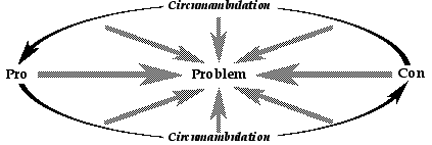Walking Around the Problem

It helps to see a problem
from all sides
At dinner the boy had asked "will you teach me how to drive this weekend?" and his father had said "sure" but then Mom spoke up and said, "now wait a minute; you can't teach him how to drive, he doesn't have a permit and we don't have insurance for him yet." Dad thought for a moment and then said, "well then, let's bring this into our session tonight."
They had gone far enough into their family work together to know that a look at the issue in a different slant, in session, might bring some resolution to their disagreement. I suggested that the four of us (Son included) think of all the reasons Dad should not teach Son to drive that weekend, and write them down on one side of a sheet of paper, while on the other side of the same page we could list all the reasons why he should.
Everyone joined in, turning the page over and over as they thought of yet another reason, either way, and letting go of their individual attitudes in a willingness to work together on the problem as a team.
Attitude is a word that has a particular meaning in aeronautics: it refers to the way the ground appears, given our position in the sky. Bank in one direction or another, climb or dive, and everything suddenly looks different— not because they have changed on the ground below, but because we have changed in the air above. Copping an attitude has everything to do with how we choose to stand in life, and how we may refuse to budge.
It's interesting to see how, in discussing a problem, we can so easily become identified with one position or another from the start, and can spend the entire discussion defending or attacking a particular point of view. To a neutral observer, our opinions tell more about us and the stance we have taken in life, than they will about the problem we are discussing.
Debate is exhilarating, and perhaps an efficient way to get to one bottom line or another, but (as with competition of any kind) there must be a winner and a loser, and the winner will always appear more competent than the loser. The problem is this usually means that every winner must be married (or in some other way related closely) to a loser— and what kind of winner is that?
Collaboration is of course a much more effective, much more graceful and elegant way to the final solution of the dichotomy, but how do we begin? How can we remember to have the insight and empathy about another point of view than our own? Perhaps here there is room for a bit of healthy competition: the first one to notice the stand-off and point it out, the first one to suggest joining in on the problem rather than attacking it from opposite sides, wins!
Pro will always be versus Con, but we also, always, can step away from that frozen posture and join one another in what Jung once called a circumambulation of the issue, a walking around of it, hand in hand. The problem under discussion should never come between us, because we will then confuse one another with it and come to believe that the other person is the real problem. Rather, we should keep each other nearby, as a partner, as we view the problem from all sides, together.
In discussing the issue about learning to drive in this collaborative way, father, mother and son soon gathered enough evidence on both sides, pro and con, to recognize the real bottom line without the need for any debate. Likewise (and more important) they recognized the need to explore and discuss family issues such as this rather than fight them out.
Such discussions show how the family can be composed of people involved in a life together. A family not put to use in this way will become, in time, a family that is all used up; and the people who then escape into their own adult lives may tend to use people themselves, may become abusive rather than useful.
Return to Clinical Commentary
